People are generally better educated and more worldly, thanks to the greater availability of third-level education and the opportunity to travel.
Would you agree?
Yet, employers still tell me there is a continuing reluctance on behalf of their employees to speak up in meetings or present on behalf of the organisation. This reluctance now also extends to picking up the phone and calling someone.
I do not doubt that this reluctance is due to receiving unsolicited (so-called) constructive criticism in their earlier life.
The reason for people’s reluctance to speak up is they believe that they’re not good enough.
When I was studying to be a Dale Carnegie trainer back in the nineties, this was good advice I received from my American coach, Bob Pank:
“If you cannot find the good in people, it’s your fault, not theirs”.
I have now been a communications coach for twenty-five years and believe I have never told anybody what they were doing wrong. I always provide positive coaching, leading to people becoming confident communicators.
Here is some invaluable advice to speakers and those who send them out to speak on behalf of organisations.
Having listened to somebody present to you, are you likely to remember everything they said?
No, that’s very unlikely!
However, you will remember how they made you feel – uplifted, informed, enthused, energised, happy, and inspired!
“Nobody remembers what you say, they remember how you made them feel –
Joyful, Giddy, Laughed a lot.” Jimmy Carr – Comedian
Would you be happy if your listeners experienced some of these emotions when you were speaking?
Here is what good conversationalists do:
They listen!
How can I listen if I’m talking to them, I hear you say?
Firstly, I help people realise that they can both speak and think at the same time; it’s not that difficult, honestly!
When your audience is doing the following, it’s a conversation:
Looking back at you, making eye contact, smiling, nodding, frowning, laughing – in other words, engaged.
Not engaging looks like this:
They are checking their devices, texting, emailing, nodding off, looking at their watch, and tapping its face.




